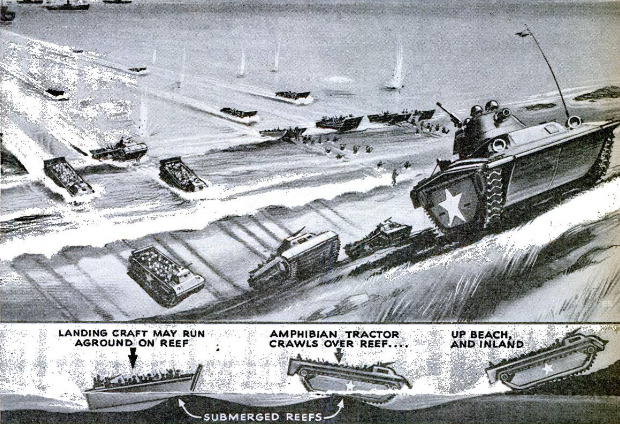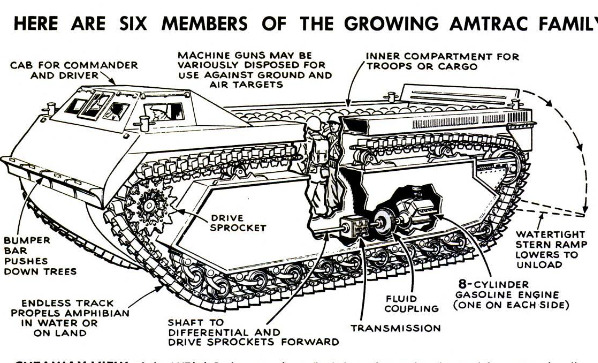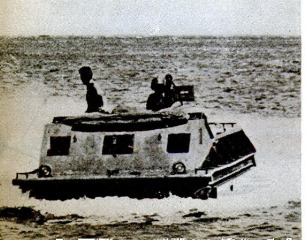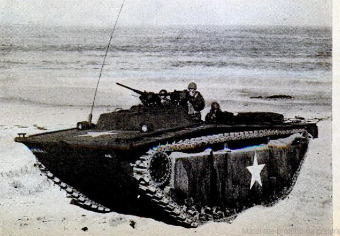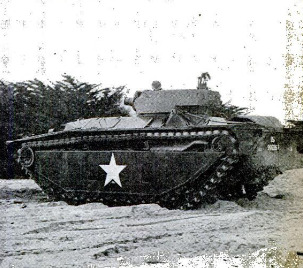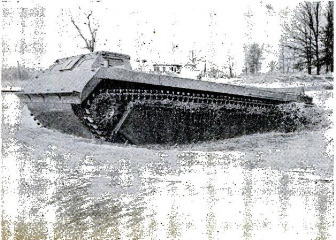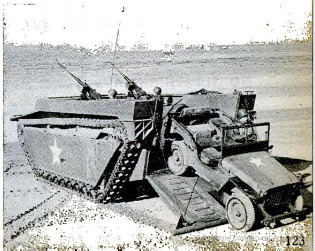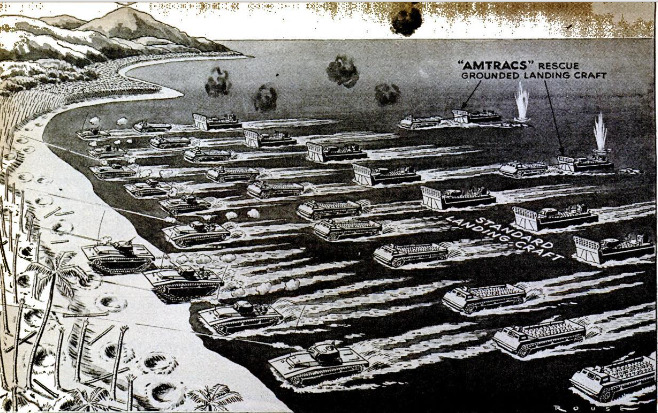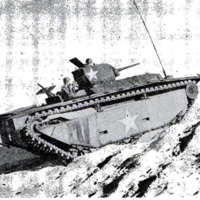-
Title (Dublin Core)
-
Meet the LVT's beach busters
-
Article Title and/or Image Caption (Dublin Core)
-
Title: Meet the LVT's beach busters
-
extracted text (Extract Text)
-
AT OKINAWA, the newest members of
America’s growing family of Amtracs
waddled ashore, toted cargoes up the hills
to the front line, and hauled back the
wounded men. So censorship now has been
lifted sufficiently to permit you to know
about our newest amphibian tractors. |
Like the Alligator and the Water Buf-
falo, these new Amtracs are officially LVT's
(Landing Vehicles, Tracked). They have
neither wheels nor propellers, but travel
over land or water by using their endless
tracks as ground grippers on terra firma |
and as paddles in the sea. |
They are descendants of a “rescue tank”
invented a dozen years ago by Donald |
Roebling, grandson of the famous bridge
builder, to save persons marooned in the
Florida Everglades by tropical hurricanes.
Navy and Marine Corps experts saw news
pictures of Roebling’s machine (P.S.M.,
Jan. '36, p. 42), and ordered a couple of
aluminum pilot models. Few persons sus-
pected then that Roebling’s invention would
help to shorten bombers’ flights to Tokyo
in 1945, but that's exactly what his ma-
chine's descendants have done. They've now
swum and rolled to within 350 miles of
Japan.
If you want to be technically correct,
don’t speak of an LVT as an “amphibian
tank" —especially if you are talking with
a certain Marine Corps officer who had three
shot out from under him in a single engage-
ment. The ones that carry troops or cargo
are “amphibian tractors,” or Amtracs for
short, and their thin plating stops nothing
heavier than small-arms or light machine-
gun fire. Therefore, their attack often is led
by one or two waves of armored amphibians,
a later class with more protection.
Typical armament for an amphibian trac-
tor consists of four machine guns—either
two .50's and two .30's, or all .50's. The
choice depends upon a nicety of tactics.
Where aerial opposition is expected, the
.50 caliber weapon serves as an antiaircraft
gun and is used throughout. But when Allied
airpower neutralizes the enemy's, .30 caliber
bullets kill Japs on the ground just as effec-
tively, and more ammunition can be stowed
aboard. Armored amphibians mount both
machine guns and comparatively heavy
weapons—a 37-mm. gun or a 75-mm.
howitzer—and start firing from the water
as soon as the preliminary barrage from
major warships has lifted.
Fuel tanks filled with high-test gasoline,
invasion-bound LVT's take to the water
from the lowered bow of an LST—the
Navy's versatile ocean-going vessel named
for its original use as a Landing Ship, Tank.
By way of comparison, it takes 34, min-
utes to unload 17 LVT’s from an LST; 25 to
90 minutes to unload a single LVT from a
larger ship.
Taking radio orders from their group
commanders, the amphibians first jockey
into place on the “line of departure”—a
standard assault formation, resembling that
of race horses at the barrier. A second com-
mand, and they're off. Don't expect them
to show spectacular speed, for they're work
horses rather than sprinters, with a pace
of four or five knots in the water.
As an Amtrac nears a hostile shore, the
spang of bullets against its side warns oc-
“ cupants not to risk a peek at what is going
on, but to crouch in safety. Usually an ob-
server in a protected position volunteers
a running account of the situation. |
Given sufficient notice where to land,
the driver stars in the climax of the show.
It is up to him to beach the machine through
heavy surf, if necessary, and thorough
training has taught him just how to do it.
Above all, he must never let a wave catch
him abeam. True, LVT's have power pumps
that discharge water normally shipped
aboard—but, for all their virtues, Amtracs
are not submarines.
A grating noise announces that the LVT
has reached shore, and, dripping brine, it
goes into action in its terrestrial element.
Incidentally, the design of its double-pur-
pose track cleats deserves more than a
passing glance; shaped like the blades of
a Pelton water wheel, they have applied a
classic hydraulic principle in reverse, for
aquatic propulsion. Like the tracks of a
land tank, they are used for steering, both
afloat and ashore. To turn, the driver runs
one track faster than the other; to face
about, he operates them in reverse directions.
On land, the 20-mile-an-hour speed of an
LVT cannot compete with
that of a tank. Where it
scores again is in its incom-
parable ability to overcome
every variety of difficult ter-
rain. Marines struck a curi-
ous type on the beach of Iwo
Jima—volcanic sand, so soft and yielding
that they might as well have been strug-
gling through a quagmire. But their am- |
phibian tractors rode over it with ease.
Likewise, as at Bougainville, tropical rains
that turn roadways into beds of thick mud
cannot stop them. During the Cape Glouces-
ter invasion of New Britain, our troops re-
ceived supplies in LVT’s over no roads at all.
Marines consider them tops among jungle
machines. They have enough power to |
crash through the toughest thickets, and to |
run up hills too
steep for land tanks. A high bumper bar, '
compared to that of a tank, gives the am-
phibians enough leverage to push over trees
up to eight inches in diameter—a useful
trick to clear ground for artillery aiming
stakes. Armored amphibians make mobile
fieldpieces. And although theoretically no
match for tanks in combat, even amphibious
tractors are unofficially reported to have
destroyed Jap tanks.
The 21-foot, eight-ton Alligator was the
first Amtrac to see combat action, taking
part in the initial assault upon Guadalcanal
on August 7, 1942. When the Japs got their
| first glimpse of these awe-inspiring machines
crawling in from the sea, their dismay may
well be imagined. According to a Marine
officer who led one of the first waves of am-
phibians, the Nipponese departed precipi-
tately and the Amtracs landed without
appreciable opposition.
No one could expect a perfect amphibian
on the first try, but the Alligators proved
themselves so well in subsequent actions
that many are still in use. Meanwhile, im-
proved models had answered obvious de-
mands for more size and power.
These were the LVT (2), the Water Buf-
falo, 26 feet long and of 14 tons, which first
hit the Japs at Bougainville on November 1,
1943, and the first U. S. armored amphibian,
the LVT (A) (1), which first saw action
at Kwajalein, on February 1, 1944. Designed
solely for fighting, this six-man vehicle bore
the closest resemblance to a seagoing tank.
The 18-tonner, armed with a 37-mm. gun,
carried machine guns as well. Heavier ar-
mor protected the crew.
Combat experience, not theorizing, dic-
tates changes in models. For example, men
of the Alligators and Water Buffaloes had
to disembark by leaping over the sides of
the machine, and unload cargo the same
unhandy way, while exposed to enemy fire.
Thenceforth, Amtracs were fitted with built-
in stern ramps. Impervious to the sea, the
rubber-sealed platforms were readily low-
ered when the craft got ashore, making an
easy task of unloading cargo and enabling
troops to deploy under cover of the vehicle.
First of these ramp-type amphibians to
introduce itself to the Japs was the LVT
(4), an enlarged and improved Water Buf-
falo, 26 feet long, a ton or two heavier than
its predecessor, and carrying an infantry
platoon of 32 to 45 men, or a land-type jeep,
or a sizable fieldpiece, complete with crew.
It was the second unpleasant surprise of
the day, June 14, 1944, for the Nipponese
defenders of Saipan in the Marianas. The
~ first had been an advance assault by our
latest armored amphibian, the LVT (A)
_ (4)—a 20-ton fighting machine with a crew
of five and a 75-mm. howitzer for its prin-
cipal armament. Its shells, each measuring
a shade under three inches in caliber, can
be aimed to sail over ridges surrounding a
beachhead and plop down among Japanese
concentrations detected by aerial recon-
naissance.
Military machines don't always appear in
the same order as their model numbers. So
it was with the LVT (3), a beautiful piece
of engineering, which remained under wraps
while the LVT (4) and other Amtracs led
the march across the Pacific and some
ferried American armies across the Rhine.
Then, last Easter Sunday, the Bushmaster
went into combat at Okinawa, with the re-
sult already described.
About equal to the LVT (4) in tonnage
and capacity, a little shorter and beamier,
the Bushmaster differs from the Water Buf-
falo in one outstanding respect. Its driver
has practically been relieved from the tricky
business of shifting gears in climbing a reef,
a beach, or a hillside. For the LVT (3) em-
ploys a fluid transmission, similar in prin-
ciple to those of modern cars, and automa-
tically changes gears to suit the “road.”
In round numbers, America has built
something over 15,000 LVT’s, according to
best available estimates. Many more, and
for new uses, are due.
Unarmed and unarmored, modified Water
Buffaloes and Bushmaster are scheduled to
appear soon. They will form the last link
of our vast transportation system for rein-
forcements and supplies across the Pacific,
to the forward combat zone where fighting
amphibians take over.
Already talk is heard of odd postwar uses
for demilitarized amphibians—ferrying log-
ging equipment to hitherto inaccessible tim-
ber lands, or leading expeditions in search
of rubber, quinine, and valuable minerals.
For a while, these fascinating speculations
must wait. The amphibians have another
job to finish first.
-
Contributor (Dublin Core)
-
Alden P. Armagnac (article writer)
-
Language (Dublin Core)
-
Eng
-
Date Issued (Dublin Core)
-
1945-09
-
pages (Bibliographic Ontology)
-
121-124,206
-
Rights (Dublin Core)
-
Public domain
-
Archived by (Dublin Core)
-
Sami Akbiyik
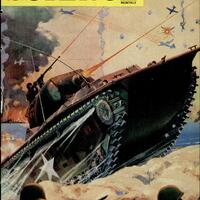 Popular Science Monthly, v. 147, n. 3, 1945
Popular Science Monthly, v. 147, n. 3, 1945

